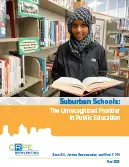Take the Pop Quiz
Urban schools have been the center of investment and concern in public education for the past two decades. Yet many suburban districts now rival urban districts in the challenges they face, having experienced dramatic population changes in just the past decade, with fast growing numbers of English Language Learners and students living in poverty attending suburban schools.
Our new paper reviews the trends around these changing student populations and the accompanying demands facing suburban public school systems. For example:
- Between 2000 and 2012, populations living below the federal poverty line grew nearly three times as fast in suburbs as in cities.
- In Highline Public Schools, just outside of Seattle, the number of students qualifying for free and reduced-price lunch has increased by over 25 percentage points since 1998, and ELLs grew from 7% to 21%.
- In neighboring Kent, Washington, in the past decade the ELL student population grew from 3% to 14% in a system of 27,000 students.
- In Minnesota’s suburbs, half of the ELL population are refugees, which brings challenges beyond just navigating language barriers.
- In Prince George’s County, Maryland, FRL students grew from 44% to 59% between 2003 and 2013 (just two percentage points lower than nearby Washington, D.C.).
While some might argue that suburbs have been lucky to avoid battles over education policy, teacher strikes, and state interventions, many suburbs are economically distressed and not well equipped to handle the new challenges associated with disadvantaged students.
The authors have suggestions as to how suburban leaders and others can support smart changes to help their school systems address the risks and opportunities associated with these rapid population changes.






